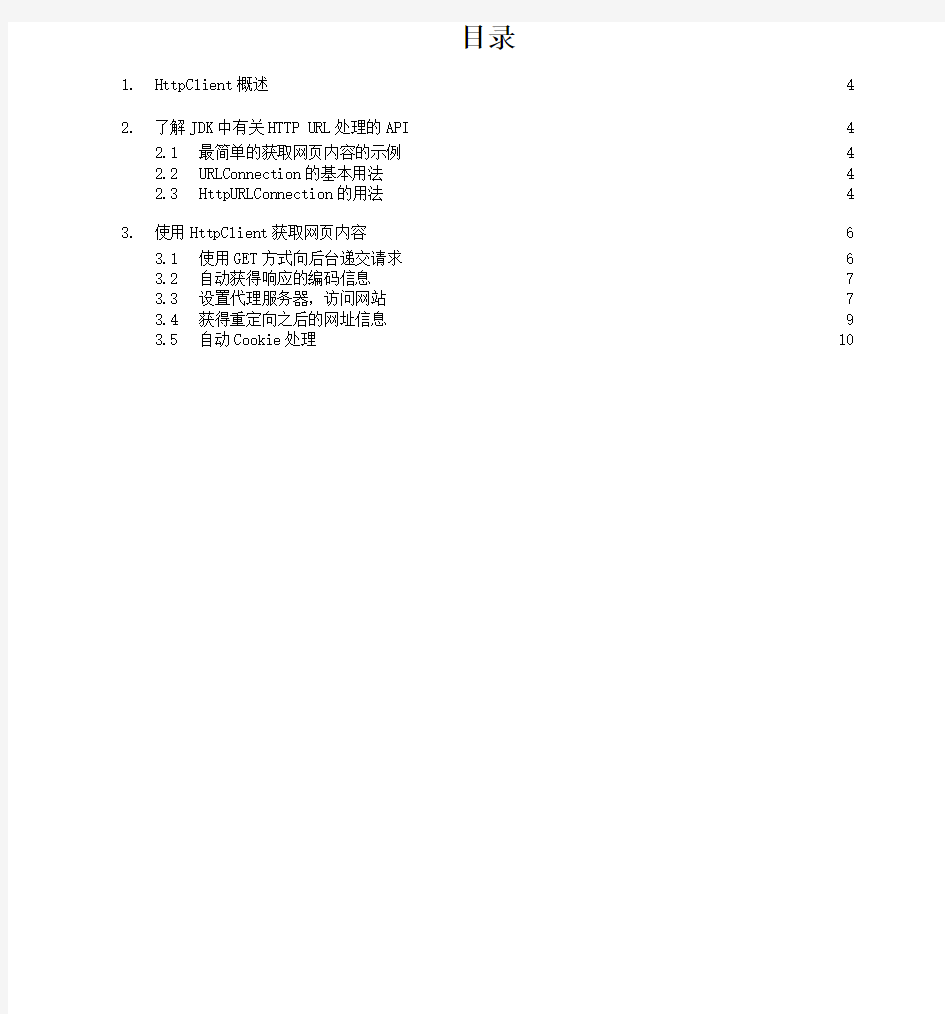HttpClient入门


目录
1.HttpClient概述 4
2.了解JDK中有关HTTP URL处理的API 4
2.1最简单的获取网页内容的示例 4
2.2URLConnection的基本用法 4
2.3HttpURLConnection的用法 4
3.使用HttpClient获取网页内容 6
3.1使用GET方式向后台递交请求 6
3.2自动获得响应的编码信息 7
3.3设置代理服务器,访问网站 7
3.4获得重定向之后的网址信息 9
3.5自动Cookie处理 10
HttpClient入门
1.HttpClient概述
HttpClient是apache组织下面的一个用于处理HTTP请求和响应的开源工具。它不是一个浏览器,也不处理客户端缓存等浏览器的功能。它只是一个类库!它在JDK的基本类库基础上做了更好的封装! HttpClient目前(写作本文日期:2010年8月)最新版本是4.0.1,官方网址:
https://www.360docs.net/doc/0c13470340.html,/httpcomponents-client-4.0.1/index.html
HttpClient项目依赖于HttpCore(处理核心的HTTP协议)、commons-codec(处理与编码有关的问题的项目)和commons-logging(处理与日志记录有关问题的项目)。
如果你希望能够通过HttpClient向服务器上传文件等与multipart编码类型有关的请求,以及其它复杂的MIME类型,那么,你需要另外一个依赖包:HttpMime(它是专门处理与MIME类型有关问题的项目),在下载的HttpClient包中(下载地址为:https://www.360docs.net/doc/0c13470340.html,/downloads.cgi)已经包含了HttpMime。
在本文中,我们使用的HttpClient版本为:4.0.1GA
开始使用HttpClient,我们加入了下列依赖包:
httpclient-4.0.1.jar
httpcore-4.0.1.jar
httpmime-4.0.1.jar
- 又依赖于mime4j(apache-mime4j-0.6.jar)
commons-codec-1.4.jar
commons-logging-1.1.1.jar
commons-io-1.4.jar – 为了更方便处理与IO有关的需求
【如果你下载的是包含依赖包的压缩包,那么上述依赖包(除commons-io-1.4.jar外)都已经在其中了!】
2.了解JDK中有关HTTP URL处理的API
因为HttpClient是对JDK中https://www.360docs.net/doc/0c13470340.html,.*包下面的有关基础类库的封装,所以,我们有必要了解一下,这些基础类库的简单用法和概念。
2.1最简单的获取网页内容的示例
try {
String urlString = "http://localhost:8080/cms/";
URL url = new URL(urlString); //代表了一个网址
InputStream is = url.openStream(); //获得网页的内容
//将InputStream转换为Reader,并使用缓冲读取,提高效率,同时可以按行读取内容
BufferedReader br = new BufferedReader(new InputStreamReader(is,"UTF-8"));
String line = null;
while((line = br.readLine()) != null){
System.out.println(line);
}
is.close();
} catch (Exception e) {
e.printStackTrace();
}
上述例子,直接通过URL获得输入流,然后对其进行处理!
2.2URLConnection的基本用法
上述例子太过简单,假如你需要通过代理来访问网络,那么,你需要的是URLConnection!即,在获取内容之前,先设置代理!
public void testFetch02(){
try {
urlString
=
String
"https://www.360docs.net/doc/0c13470340.html,/developerworks/cn/java/j-javaroundtable/index.html";
new URL(urlString); //代表了一个网址
=
URL
url
//首先创建HTTP代理,指定代理的地址和端口
=
new Proxy(Proxy.Type.HTTP,new
proxy
Proxy
InetSocketAddress("79.120.193.53",80));
/**
*首先打开一个连接对象
*可以通过这个对象,在真正发起请求之前,设置一些其它的信息
*比如:代理服务器等
*/
URLConnection conn = url.openConnection(proxy);
InputStream is = conn.getInputStream(); //获得网页的内容
//将InputStream转换为Reader,并使用缓冲读取,提高效率,同时可以按行读取内容
new BufferedReader(new
=
BufferedReader
br
InputStreamReader(is,"UTF-8"));
null;
=
String
line
while((line = br.readLine()) != null){
System.out.println(line);
}
is.close();
} catch (Exception e) {
e.printStackTrace();
}
可以设置HTTP或SOCKS代理,只要指定不同的代理类型即可!
2.3HttpURLConnection的用法
HttpURLConnection是URLConnection的子类,它提供了更多与HTTP有关的处理方法,
*比如:如果你希望获得服务器响应的HTTP代码,比如:2XX,3XX等
*比如:你希望设置是否自动进行客户端重定向(缺省是自动重定向)
*比如:你希望指定向服务器提交的HTTP METHOD(GET或POST等)
等等等等
try {
String urlString =
"http://localhost:8080/cms/backend/main.jsp";
URL url = new URL(urlString); //代表了一个网址
//设置是否自动进行重定向,缺省这个值为true
HttpURLConnection.setFollowRedirects (false );
HttpURLConnection conn =
(HttpURLConnection)url.openConnection();
//设置HTTP METHOD
conn.setRequestMethod("GET");
int code = conn.getResponseCode();
System.out .println("服务器响应代码为:"+code);
InputStream is = conn.getInputStream();
//将InputStream 转换为Reader ,并使用缓冲读取,提高效率,同时可以按行读取内容
BufferedReader br = new BufferedReader(new
InputStreamReader(is,"UTF-8"));
String line = null ;
while ((line = br.readLine()) != null ){
System.out .println(line);
}
is.close();
} catch (Exception e) {
e.printStackTrace();
}
上述例子中,由于设置了不自动重定向,所以,加入main.jsp 返回的是一个3XX 代码(客户端重定向),那么将获取不到任何内容!假如设置了自动重定向,将获得重定向之后的网页的内容!
3. 使用HttpClient 获取网页内容
在进行下述例子之前,请添加上面所用到的依赖包!
3.1 使用GET 方式向后台递交请求
public void testFetch01(){
try {
//HttpClient 主要负责执行请求
HttpClient httpclient = new DefaultHttpClient();
//利用HTTP GET 向服务器发起请求
HttpGet get = new HttpGet("http://localhost:8080/cms");
//获得服务器响应的的所有信息
HttpResponse response = httpclient.execute(get);
//获得服务器响应回来的消息体(不包括HTTP HEAD )
HttpEntity
response.getEntity();
=
entity
if(entity != null){
=
entity.getContent();
InputStream
is
//将InputStream转换为Reader,并使用缓冲读取,提高效率,同时可以按行读取内容
new BufferedReader(new
=
BufferedReader
br
InputStreamReader(is,"UTF-8"));
=
null;
line
String
while((line = br.readLine()) != null){
System.out.println(line);
}
is.close();
}
//释放所有的链接资源,一般在所有的请求处理完成之后,才需要释放
httpclient.getConnectionManager().shutdown();
} catch (ClientProtocolException e) {
e.printStackTrace();
} catch (IOException e) {
e.printStackTrace();
}
}
3.2自动获得响应的编码信息
我们希望程序能够自动分辨响应的内容的编码
public void testFetch02(){
try {
//HttpClient主要负责执行请求
new DefaultHttpClient();
=
httpclient
HttpClient
//利用HTTP GET向服务器发起请求
new HttpGet("https://www.360docs.net/doc/0c13470340.html,/");//new
=
get
HttpGet
HttpGet("http://localhost:8080/cms");
//获得服务器响应的的所有信息
httpclient.execute(get);
=
HttpResponse
response
//获得服务器响应回来的消息体(不包括HTTP HEAD)
=
response.getEntity();
entity
HttpEntity
if(entity != null){
//获得响应的字符集编码信息
//即获取HTTP HEAD的:Content-
Type:text/html;charset=UTF-8中的字符集信息
=
String
charset
EntityUtils.getContentCharSet(entity);
System.out.println("响应的字符集是:"+charset);
entity.getContent();
=
is
InputStream
//使用响应中的编码来解释响应的内容
new BufferedReader(new
=
br
BufferedReader
InputStreamReader(is,charset));
null;
String
=
line
while((line = br.readLine()) != null){
System.out.println(line);
}
is.close();
}
//释放所有的链接资源,一般在所有的请求处理完成之后,才需要释放
httpclient.getConnectionManager().shutdown();
} catch (ClientProtocolException e) {
e.printStackTrace();
} catch (IOException e) {
e.printStackTrace();
}
}
上述例子,主要是通过EntityUtils.getContentCharSet方法来获得编码信息
3.3设置代理服务器,访问网站
public void testFetch03(){
try {
//HttpClient主要负责执行请求
HttpClient
=
new DefaultHttpClient();
httpclient
//设置代理服务器
httpclient.getParams().setParameter(ConnRoutePNames.DEFAULT_PROXY, new HttpHost("121.12.249.207",3128));
//利用HTTP GET向服务器发起请求
HttpGet
=
new HttpGet("https://www.360docs.net/doc/0c13470340.html,/");//new
get
HttpGet("http://localhost:8080/cms");
//获得服务器响应的的所有信息
=
httpclient.execute(get);
response
HttpResponse
//获得服务器响应回来的消息体(不包括HTTP HEAD)
=
response.getEntity();
entity
HttpEntity
if(entity != null){
//获得响应的字符集编码信息
//即获取HTTP HEAD的:Content-
Type:text/html;charset=UTF-8中的字符集信息
charset
=
String
EntityUtils.getContentCharSet(entity);
System.out.println("响应的字符集是:"+charset);
entity.getContent();
=
InputStream
is
//使用响应中的编码来解释响应的内容
new BufferedReader(new
=
BufferedReader
br
InputStreamReader(is,charset));
String
=
null;
line
while((line = br.readLine()) != null){
System.out.println(line);
}
is.close();
}
//释放所有的链接资源,一般在所有的请求处理完成之后,才需要释放
httpclient.getConnectionManager().shutdown();
} catch (ClientProtocolException e) {
e.printStackTrace();
} catch (IOException e) {
e.printStackTrace();
}
}
主要通过httpclient.getParams().setParameter 方法设置代理服务器。
HttpHost是HttpClient中用来表示一台主机的类。
3.4获得重定向之后的网址信息
HttpClient缺省情况下自动处理客户端重定向,即当你访问网页(比如A网页)之后,假设被重定向到了
B网页,那么,HttpClient将自动返回B网页的内容,无需再编程处理它!有时候我们可能想要知道A网
页被重定向到了哪里,也就是取得B网页的网址,那么可以通过下述例子获得:
public void testFetch04(){
try {
//HttpClient主要负责执行请求
=
new DefaultHttpClient();
httpclient
HttpClient
new BasicHttpContext();
=
HttpContext
context
//利用HTTP GET向服务器发起请求
=
new
get
HttpGet
HttpGet("http://localhost:8080/cms/backend/main.jsp");
//获得服务器响应的的所有信息
=
httpclient.execute(get,context);
response
HttpResponse
//获得重定向之后的主机地址信息
=
HttpHost
targetHost
(HttpHost)context.getAttribute(ExecutionContext.HTTP_TARGET_HOST);
System.out.println(targetHost); // http://localhost:8080
//获得实际的请求对象的URI(即重定向之后的
"/cms/backend/login.jsp")
(HttpUriRequest)
=
actualRequest
HttpUriRequest
context.getAttribute(ExecutionContext.HTTP_REQUEST);
System.out.println(actualRequest.getURI());
//获得服务器响应回来的消息体(不包括HTTP HEAD)
response.getEntity();
=
entity
HttpEntity
if(entity != null){
//获得响应的字符集编码信息
//即获取HTTP HEAD的:Content-
Type:text/html;charset=UTF-8中的字符集信息
=
String
charset
EntityUtils.getContentCharSet(entity);
System.out.println("响应的字符集是:"+charset);
InputStream
=
entity.getContent();
is
//使用响应中的编码来解释响应的内容
=
new BufferedReader(new
br
BufferedReader
InputStreamReader(is,charset));
null;
=
String
line
while((line = br.readLine()) != null){
System.out.println(line);
}
is.close();
}
//释放所有的链接资源,一般在所有的请求处理完成之后,才需要释放
httpclient.getConnectionManager().shutdown();
} catch (Exception e) {
e.printStackTrace();
}
}
HttpContext,实际上是客户端用来在多次请求-响应的交互中,保持状态信息用的。假如我们在调用httpclient.execute方法的时候,将HttpContext对象作为参数传给这个方法(请看上述例子),那么HttpClient将把请求-响应交互过程中的状态信息存储在HttpContext中。
比如上面的例子中,HttpClient把主机信息和真正的请求对象(所谓真正的请求对象,因为我们发出的是main.jsp的请求,但这个请求实际上被重定向到了login.jsp,所以真正的请求对象实际上是
login.jsp)等信息(请参考文档说明)放到了HttpContext中!
我们自己也可以利用HttpContext来存放一些我们想要存放的其它信息,以便下次请求的时候,能够把这些信息拿出来使用!
3.5自动Cookie处理
HttpClient能够支持自动Cookie处理。设想一个典型的场景:首先打开登录页面,然后输入用户名和密码登录,然后访问那些只有登录之后才能访问的网页……
如果我们用浏览器,因为浏览器可以将登录之后的会话信息用Cookie存储在本地,所以,登录之后的每次请求,都会自动向服务器发送Cookie的信息,我们利用HttpClient,这些过程都全部可以自动化处理了。
public void testFetch05(){
try {
//HttpClient主要负责执行请求
new DefaultHttpClient();
=
HttpClient
httpclient
new BasicHttpContext();
=
context
HttpContext
//利用HTTP GET向服务器发起请求,
new
=
get
HttpGet
HttpGet("http://localhost:8080/cms/backend/login.jsp");
//获得服务器响应的的所有信息
=
httpclient.execute(get,context);
response
HttpResponse
//获得服务器响应回来的消息体(不包括HTTP HEAD)
response.getEntity();
=
entity
HttpEntity
=
null;
charset
String
if(entity != null){
//获得响应的字符集编码信息
//即获取HTTP HEAD的:Content-
Type:text/html;charset=UTF-8中的字符集信息
=
EntityUtils.getContentCharSet(entity);
charset
System.out.println("响应的字符集是:"+charset);
entity.getContent();
=
InputStream
is
//使用响应中的编码来解释响应的内容
new BufferedReader(new
=
br
BufferedReader
InputStreamReader(is,charset));
null;
String
=
line
while((line = br.readLine()) != null){
System.out.println(line);
}
is.close();
}
//************* 执行登录请求 ********************//
new
=
post
HttpPost
HttpPost("http://localhost:8080/cms/backend/LoginServlet");
//添加POST参数
new ArrayList
=
List
nvps
nvps.add(new BasicNameValuePair("username","admin"));
nvps.add(new BasicNameValuePair("password","admin"));
post.setEntity(new UrlEncodedFormEntity(nvps,charset));
httpclient.execute(post);
=
response
response.getEntity();
=
entity
if(entity != null){
entity.getContent();
=
is
InputStream
//使用响应中的编码来解释响应的内容
=
new BufferedReader(new
br
BufferedReader
InputStreamReader(is,charset));
=
null;
line
String
while((line = br.readLine()) != null){
System.out.println(line);
}
is.close();
}
//******************* 请求文章查询 ********************//
new
=
get
HttpGet("http://localhost:8080/cms/backend/ArticleServlet");
httpclient.execute(get);
=
response
response.getEntity();
=
entity
if(entity != null){
entity.getContent();
=
is
InputStream
//使用响应中的编码来解释响应的内容
=
new BufferedReader(new
br
BufferedReader
InputStreamReader(is,charset));
=
null;
line
String
while((line = br.readLine()) != null){
System.out.println(line);
}
is.close();
}
//释放所有的链接资源,一般在所有的请求处理完成之后,才需要释放 httpclient.getConnectionManager().shutdown();
} catch (Exception e) {
e.printStackTrace();
}
}
